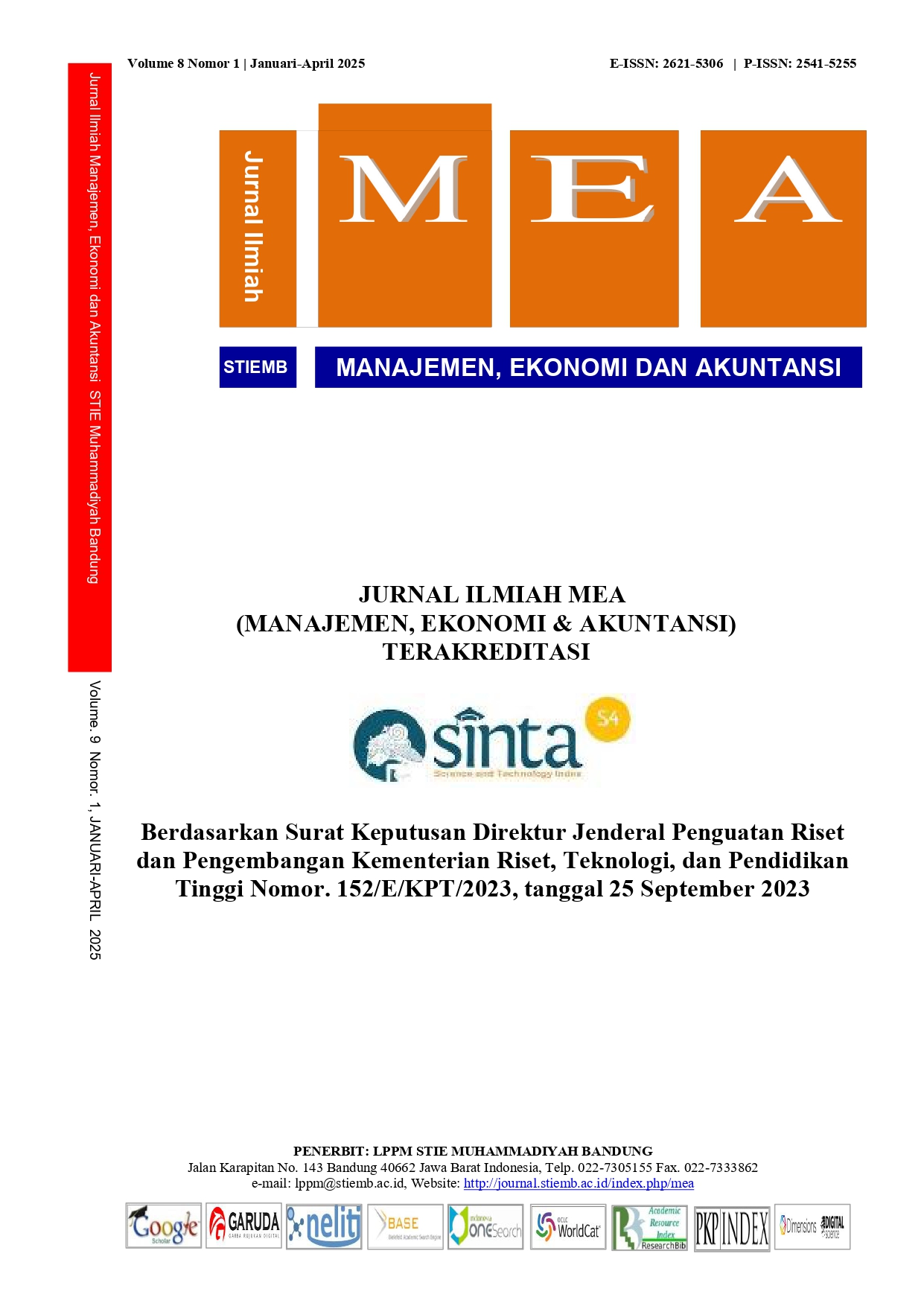PENGARUH INFORMATION ADOPTION TERHADAP PURCHASE INTENTION DENGAN VARIABEL HERD BEHAVIOUR SEBAGAI VARIABEL INTERVENING PADA USAHA DAEBAG.E
Abstract
Industri makanan dan minuman menjadi salah satu bisnis yang menjanjikan karena pertumbuhannya yang selalu meningkat dari tahun ke tahun, bahkan industri ini mampu bertahan pada saat dan pasca covid-19. Melihat peluang tersebut, Daebag.e berdiri menjadi salah satu usaha makanan yang menawarkan makanan khas Korea yang digemari oleh banyak orang. Tujuan dari penelitian ini adalah untuk mengetahui pengaruh Information Adoption terhadap Purchase Intention dengan variabel Herd Behaviour sebagai variabel intervening pada Daebag,e di Surabaya. Ukuran sampel pada penelitian ini dilakukan dengan menggunakan rumus Hair berjumlah 113 responden. Teknik pengambilan sampel menggunakan purposive sampling. Data diperoleh menggunakan kuesioner yang diukur dengan skala Likert. Penelitian ini menggunakan analisis SEM-PLS untuk menganalisis pengukuran model dan structural. Berdasarkan hasil penelitian bahwa Information Adoption berpengaruh signifikan terhadap Purchase Intention Daebag.e, Information Adoption berpengaruh signifikan terhadap Herd Behaviour, Herd Behaviour berpengaruh signifikan terhadap Purchase Intention Daebag.e, Information Adoption berpengaruh signifikan terhadap Purchase Intention melalui Herd Behaviour.
References
Angst, C. M., Agarwal, R., Sambamurthy, V., & Kelley, K. (2010). Social contagion and information technology diffusion: The adoption of electronic medical records in US hospitals. Management Science, 56(8), 1219–1241.
Apuke, O. D., & Omar, B. (2020). Modelling the antecedent factors that affect online fake news sharing on COVID-19: the moderating role of fake news knowledge. Health Education Research, 35(5), 490–503. https://doi.org/10.1093/her/cyaa030
Bickart, B., & Schindler, R. M. (2001). Internet forums as influential sources of consumer information. Journal of Interactive Marketing, 15(3), 31–40. https://doi.org/10.1002/dir.1014
Bowden, J. L.-H., Conduit, J., Hollebeek, L. D., Luoma-aho, V., & Solem, B. A. (2017). Engagement valence duality and spillover effects in online brand communities. Journal of Service Theory and Practice, 27(4), 877–897.
Cheung, C. M. K., Lee, M. K. O., & Rabjohn, N. (2008). The impact of electronic word‐of‐mouth. Internet Research, 18(3), 229–247.
Erjavec, J., & Manfreda, A. (2021). Online shopping adoption during COVID-19 and social isolation: Extending the UTAUT model with herd behavior. Journal of Retailing and Consumer Services, 65, 102867. https://doi.org/10.1016/j.jretconser.2021.102867
Erkan, I., & Evans, C. (2016). Social media or shopping websites? The influence of eWOM on consumers’ online purchase intentions. Journal of Marketing Communications, 24(6), 617–632.
García-Salirrosas, E. E., Acevedo-Duque, Á., Marin Chaves, V., Mejía Henao, P. A. M., & Olaya Molano, J. C. (2022). Purchase Intention and Satisfaction of Online Shop Users in Developing Countries during the COVID-19 Pandemic. Sustainability, 14(10), 6302. https://doi.org/10.3390/su14106302
Hamid, E., Novialumi, A., & Rachmawati, R. (2022). Penerapan Promosi Pemasaran Digital Melalui Media Sosial pada Tempat Wisata Air Situ Rawa Gede Kota Bekasi. Jurnal Pengabdian Mandiri, 1(9), 1655-1660. https://www.bajangjournal.com/index.php/JPM/article/view/3534
Hotar, N. (2020). Herd Behaviour in Terms of Social Psychology: The Example of Crypto Asset Markets. International Journal of EBusiness andEGovernmentStudies,12(1),79–90.https://doi.org/10.34111/ijebeg.202012106
Hsu, C., Chuan‐Chuan Lin, J., & Chiang, H. (2013). The effects of blogger recommendations on customers’ online shopping intentions. Internet Research, 23(1), 69–88. https://doi.org/10.1108/10662241311295782
Huang, L. (2010). Social contagion effects in experiential information exchange on bul- letin board systems. Journal of Marketing Management, 26(3–4), 197–212.
Kotler, P., & Keller, K. (2016). Marketing Management (15th Global Edition). Vnbrims.org. https://doi.org/978-1-292-09271-3
Lascu, D.-N., Bearden, W. O., & Rose, R. L. (1995). Norm extremity and interpersonal influences on consumer conformity. Journal of Business Research, 32(3), 201–212. https://doi.org/10.1016/0148-2963(94)00046-h
Nurfajrina, A., Handayani, T., & Sari, L. P. (n.d.). The Effect of Halal Awareness and Lifestyle on the Purchase Decision of Japanese Food in Jakarta. Journal of Islamic Economics & Social Science (JIESS) P-ISSN, 2722, 7499. Retrieved March 6, 2024
Pavlović-Höck, N. (2021). Herd behaviour by information source along the consumer buying decisions. Digital Business, 2(1), 100018. https://doi.org/10.1016/j.digbus.2021.100018
Phạm, M., Vo, T., Sang Van Tran, To, H., & Lam, B. (2023). How does herd behaviour impact the purchase intention? Explore the moderating effect of risk aversion in the context of Vietnamese consumers. Acta Psychologica, 241, 104096–104096. https://doi.org/10.1016/j.actpsy.2023.104096
Sardar, A., Manzoor, A., Shaikh, K. A., & Ali, L. (2021). An empirical examination of the impact of ewom information on young consumers’ online purchase intention: Mediating role of eWOM information adoption. SAGE Open, 11(4), 21582440211052547.
Shen, X.-L., Zhang, K. Z., & Zhao, S. J. (2014). Understanding information adoption in online review communities: the role of herd factors. IEEE.
Shiller, R. J. (1995). Conversation, Information, and Herd Behavior. The American Economic Review, 85(2), 181–185. https://www.jstor.org/stable/2117915
Su, B.-C., Wu, L.-W., Lin, H., & Lin, C.-A. (2023). The Mediating Effect of Herd Behavior and Brand Attitude towards the Impact of Spokesman Credibility, Source Fit, and Online Word-of-Mouth on Purchase Intention. Sustainability, 15(1), 888. https://doi.org/10.3390/su15010888
Sussman, S. W., & Siegal, W. S. (2003). Informational Influence in Organizations: an Integrated Approach to Knowledge Adoption. Information Systems Research, 14(1), 47–65. https://doi.org/10.1287/isre.14.1.47.14767
Teng, S., Khong, K. W., Chong, A. Y. L., & Lin, B. (2016). Persuasive Electronic Word-of-Mouth Messages in Social Media. Journal of Computer Information Systems, 57(1), 76–88. https://doi.org/10.1080/08874417.2016.1181501
Torlak, N. G., Demir, A., & Budur, T. (2019). Impact of operations management strategies on customer satisfaction and behavioral intentions at café-restaurants. International Journal of Productivity and Performance Management, 69(9). https://doi.org/10.1108/ijppm-01-2019-0001
van Dam Msc, O. (2010). Exploring the effects of herding and word of mouth on purchase decisions in an online environment.
Zhou, S., & Tu, L. (2022). The effect of social dynamics in online review voting behavior. Journal of Retailing and Consumer Services, 69, 103120. https://doi.org/10.1016/j.jretconser.2022.103120
Zulkarnaen, W., Amin, N. N. (2018). Pengaruh Strategi Penetapan Harga Terhadap Kepuasan Konsumen. Jurnal Ilmiah MEA (Manajemen, Ekonomi, & Akuntansi), 2(1), 106-128.
Copyright (c) 2025 Jurnal Ilmiah Manajemen, Ekonomi, & Akuntansi (MEA)

This work is licensed under a Creative Commons Attribution-NonCommercial 4.0 International License.





















